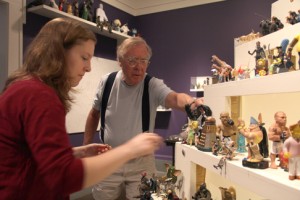The following is an excerpt from an essay by artist Daisy Rockwell about her father, whose work is currently featured in the Norman Rockwell Museum exhibition, Jarvis Rockwell: Maya, Illusion, and Us (on view through October 20, 2013):

Photo of artist Jarvis Rockwell installing “Maya V” at Norman Rockwell Museum, July 2013. Photo ©Norman Rockwell Museum. All rights reserved.
For many years after the death of his father in 1978, Jarvis stopped drawing completely and only bought and arranged a vast and growing collection of toys. These were not tasteful toys or antique toys, as people always initially assumed, but action figures, robots, plastic dollhouse furniture, and figurines from cartoons and other fantasies. When people would call this aggregation of toys a collection, he would bristle at the implications of hobbyism, but one was also unsafe simply calling it art, an assertion he would quickly counter with explanations of all kinds.
It was not until his exhibition at MASS MoCA in November 2001 that this tension began to crystallize into a philosophy that could be applied to his entire oeuvre. The exhibit consisted of a stepped pyramid covered with toys, a configuration inspired by the gopurams, or ornamented towers, that crown the entryways of Hindu temples in South India. On a family trip to Chennai, my father was entranced by one such gopuram, densely populated with small brightly painted figurines of deities and mythological figures, atop a temple in a crowded area of the city. Later this image would occur to him when he began to plan a way to display the toys in the MASS MoCA exhibition.

Photo of artist Jarvis Rockwell and Museum interns installing “Maya V” at Norman Rockwell Museum. Photo by Jeremy Clowe for Norman Rockwell Museum. All rights reserved.
The title for that show, Maya, is also taken from India. In Hindu and Buddhist philosophy, maya refers to the illusory properties of our every day existence. What we perceive to be concrete reality is nothing more than an illusion. As unenlightened humans, we believe in what we see, as might the gullible audience of a magician’s tricks. We do not know that what we perceive is an illusion, and we cannot, without enlightenment, understand the nature of our delusion.
The pyramid of toys in Jarvis’s first Maya show, and in subsequent iterations, symbolizes the fantasies we create for ourselves about the world. Toys, action figures, cartoon characters are concrete and often indestructible manifestations of the imaginary world of maya that humans have constructed and which obstructs our ability to see what is really before us and beyond us. The toys can be reconfigured in endless combinations to reflect the infinite possibilities of the maya that we weave for ourselves in every day life.
Read more of Daisy’s essay in the exhibition catalogue for Jarvis Rockwell: Maya, Illusion, and Us. Ms. Rockwell’s art can also be seen in the exhibition, Islam Contemporary, at Pittsfield’s Whitney and Lichtenstein Center for the Arts, through August 31, 2013.
Buy the exhibition catalogue in the Museum’s online store.
Meet Jarvis Rockwell in-person on Thursday, August 15, 5:30 p.m. at Norman Rockwell Museum. The artist will offer commentary and provide a tour of his exhibition. Click here for more information.

